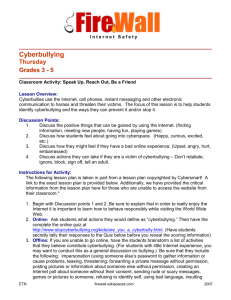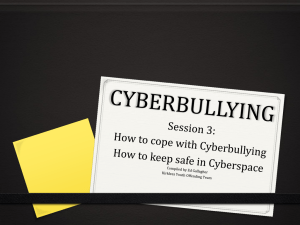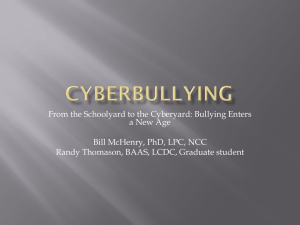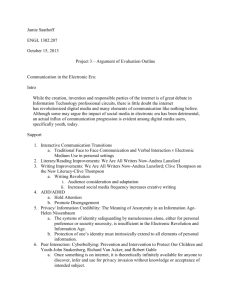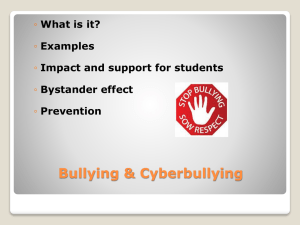File - Chrissy Garcia`s Eportfolio
advertisement
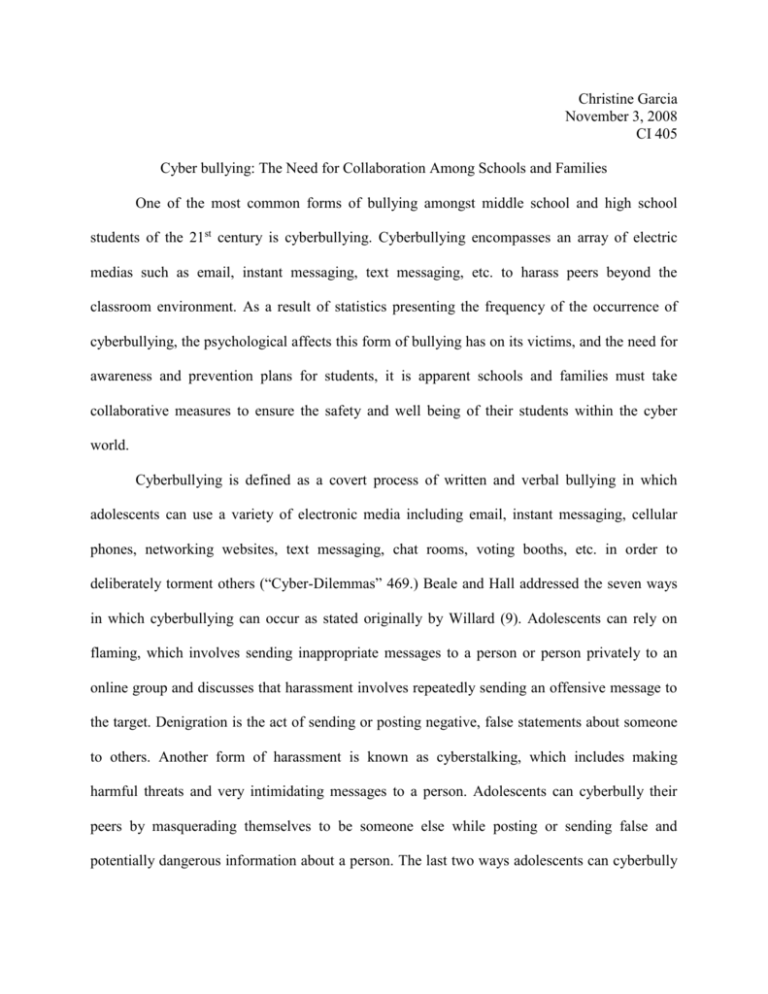
Christine Garcia November 3, 2008 CI 405 Cyber bullying: The Need for Collaboration Among Schools and Families One of the most common forms of bullying amongst middle school and high school students of the 21st century is cyberbullying. Cyberbullying encompasses an array of electric medias such as email, instant messaging, text messaging, etc. to harass peers beyond the classroom environment. As a result of statistics presenting the frequency of the occurrence of cyberbullying, the psychological affects this form of bullying has on its victims, and the need for awareness and prevention plans for students, it is apparent schools and families must take collaborative measures to ensure the safety and well being of their students within the cyber world. Cyberbullying is defined as a covert process of written and verbal bullying in which adolescents can use a variety of electronic media including email, instant messaging, cellular phones, networking websites, text messaging, chat rooms, voting booths, etc. in order to deliberately torment others (“Cyber-Dilemmas” 469.) Beale and Hall addressed the seven ways in which cyberbullying can occur as stated originally by Willard (9). Adolescents can rely on flaming, which involves sending inappropriate messages to a person or person privately to an online group and discusses that harassment involves repeatedly sending an offensive message to the target. Denigration is the act of sending or posting negative, false statements about someone to others. Another form of harassment is known as cyberstalking, which includes making harmful threats and very intimidating messages to a person. Adolescents can cyberbully their peers by masquerading themselves to be someone else while posting or sending false and potentially dangerous information about a person. The last two ways adolescents can cyberbully their peers are through outing and trickery as well as exclusion (“Cyber-Dilemmas 450”). Outing and trickery involves publicizing embarrassing information about someone through tricks and exclusion is the act of intentionally excluding someone form an online group by blocking the person to prevent access to website, chat room, discussion board, etc. The journal article addresses the fact that most students who use online media as a means of communication have all played a role in cyberbullying triad, the bully, victim, or bystander (“Cyber-Dilemmas” 450). The seven ways adolescents can cyberbully their peers is quite alarming and the above instances are occurring more frequently according to the statistics by Hinduja and Patchin. Hinduja and Patchin gave a classroom-based survey regarding cyberbullying to approximately 2000 middle school students from a large school district in the United States. Their research highlights the occurrence, specifically mentioning victims vs. offenders, of cyberbullying by gender, race, grade level, feelings, relationships between bullying and self-esteem, and bullying and suicide. Some shocking statistics include the fact that female students participating in the survey have cyberbullied people in the last 30 days and in their lifetime more than their male counterparts. Bullying gender patterns between face-to-face bullying and cyberbullying are differing. Girls are the major players in cyberbullying as opposed to males being the dominant people bullying on school campuses (Beale and Hall, 8). Beale and Hall also mention that 35 percent of girls and 11 percent of boys reported being cyberbulied at least once in a two-month period. This statistic illustrates that girls seem to play equally more frequent role in cyberbullying even as the victim. Cyberbullying can be extremely difficult for schools to address because it can occur throughout the entire day, on and off school campuses, and can be extremely anonymous which poses difficulties for school administrations handle the situations. Bullies can often hide their identities be screen names and can increase the fear factor for the victims (Beale and Hall, 8). Due to the electronic interactions, bullies and victims do not have face-to-face interactions with one another and prevents the victim from being able to defend his or herself. Stom states that bullies are not likely to feel any regret, compassion, or sympathy due to their actions because the bullying does not occur in person (22). The bully is extremely difficult to trace and does not have to face any responsibility for his or here actions (Strom & Strom, 22). Unlike typical bullying, this form can bring the harassment in the privacy of the victims’ homes as oppose to being able to leave the problem on the school playground. Cyberbullying is extremely problematic for the victims of this form of electronic harassment. According to Hinduja and Patchin’s research, the majority of the victims experience extreme anger, frustration, sadness, embarrassment, and fear as a result of the bullying, similar to how an adolescent may feel as a result of a face-to-face bully. Cyberbullying can play a severe toll on an adolescent’s psychological and emotional state. Shariff states that even though this type of bullying takes place through electronic means, it can also play a negative role in the physical environment such as the classroom (“Cyber-Dilemas”470). Cyberbullying creates a hostile, isolating environment and an unsafe atmosphere for students. As a result, students’ academic performance can decline because their mind is no longer focusing on academics, more so the social aspect of schooling. In addition, there are a startling percentage of students committing suicide as a result of the abuse. Shariff addresses the suicide of teenager Dawn Marie Wesley who hung herself after receiving threatening phone calls (“Keeping Schools Out” 226. As a result of this new form of bullying plaguing middle schools and high schools across the country, it is critical for schools and educators to be actively involved in mediating this situation. Teachers and school administrations must take responsibility for the safety and well being of their students even if it means being aware of the bullying that is occurring and straining students outside of the classroom. The courts are currently holding youth responsible for the consequences of their bullying and Shariff states that if children are being held responsible, so should professional adults if they neglect this type of bullying or fail to protect and educate students about cyberbullying (“Keeping Schools Out” 226). It is critical for schools to create guidelines that clearly state the boundaries and their responsibility in order to provide students with adequate support and to prevent negligence (“Cyber-Dilemmas” 472). Specifically, U.S. courts have established standards of care regarding psychological harm and may be held responsible for instances of suicide if they did not assess the adolescents psychological conditions (“Keeping Schools Out” 227). As a result of cyberbullying, schools and educators must be responsible for fostering a safe and secure learning environment as well as providing students with awareness and education relating to cyberbully due to its frequent appearance in schools. Schools must provide their teachers with quality professional development services in order to be prepared to recognize psychological shifts as a result of bullying and to be aware of how to handle a cyberbullying situation if it were to arise in the classroom. Educators also should be prepared to inform students of issues relating to the topic to show their knowledge of the topic and show students that they are an available source willing to help with a cyberbullying situation that students may face. Teachers must provide students with education and cyberbullying must be integrated into the classroom as a result of its’ frequency (Beale and Hall, 8). Students should be aware of proper Internet etiquette and should recognize the seriousness of cyberbullying. Teachers must create a safe and welcoming environment for students to help them build relationships with their peers and increase student comfort levels with the teacher, Strong relationships between the teacher and students may increase the comfort levels about reporting instances of cyberbullying. Cyberbullying however should not be the schools sole responsibility and parents/ families must also play collaborative role to ensure students are safe in the cyber world. Just as students and educators, parents must also be educated about what cyberbullying is and how to go about handling instances of cyberbullying. Parents must be actively involved in knowing how their child or children are using the Internet and other electronic means of communication. Many instances of cyberbullying occur in the privacy of students’ homes so parents must be able to identify if their child is experiencing cyberbullying and should know what to do if it occurs. Parents and teachers must work together to ensure the safety and wellbeing of students in the cyber world. Due to the rapid increase of instances of cyberbullying there must be a collaborative effort between parents and teacher to recognize if students are being affected by cyberbullying. If parents and educators take preventative measures such as educating students about cyberbullying, they are one step closer to keeping students safe when it comes to using the electronic forms of communication. Work Cited Beale, Andrew V. & Hall, Kimberly R. “Cyberbullying: What School Administrators (and Parents) Can Do.” Clearing House. 81.1 (2007): 8-12. “Research.” Cyberbullying.us…identifying the causes and consequences of online harassment.” 31 Oct 2008. 3 Nov 2008. <http://www.cyberbullying.us/research.php>. Shariff, S. “Cyber-Dilemmas in the New Millennium: School Obligations to Provide Student Safety in a Virtual School Environment.” McGill Journal of Education. 40.3 (2005): 46787. Strom, Paris S. & Strom, Robert D. “Cyberbullying by Adolescents: A Preliminary Assessment.” Educational Forum, 70.1(2005): 21-36 Shariff, S. “Keeping Schools Out of Court: Legally Defensible Models of Leadership.” The Educational Forum. 68.3 (2004): 222-33.
